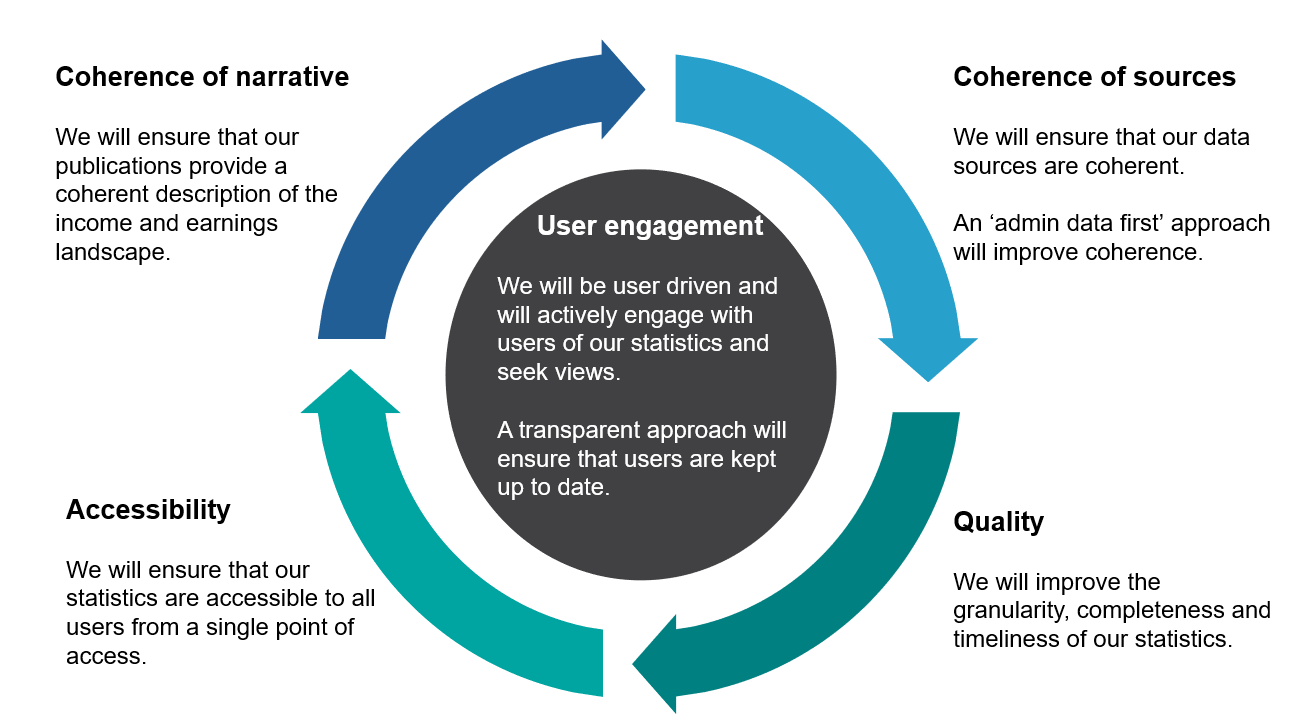Strengthening Income and Earnings statistics

The coronavirus pandemic has highlighted the importance of producing a clear and consistent UK-wide picture of people’s lives and the state of the economy. Our statistics on income and earnings are a critical component of this picture, necessary to understand its impact on wages, incomes, and more broadly household finances. Here, Debra Prestwood explains how statistical producers from across the Government Statistical Service (GSS) are coming together to improve the coherence and accessibility of these data.
Today we have published a new joint Vision statement, laying out the future of official income and earnings statistics produced by the Office for National Statistics (ONS), Department for Work and Pensions (DWP), and HM Revenue and Customs (HMRC).
By articulating what we aim to achieve, we have been able to identify actions needed to improve income and earnings statistics. Our Work Plan is focused on making improvements in five key areas: coherence of narrative, coherence of sources, accessibility, quality and user engagement.

By analysing topics of national importance, such as the impact the pandemic has had on household income, we aim to ensure our statistics remain relevant and provide a coherent narrative. We will conduct more thematic analysis, bringing together statistics from different sources to provide a single narrative for our users. In March 2020 DWP and HMRC first published children in low income families: local area statistics, bringing together data on families’ income from multiple sources to provide insight on children living in low income families.
We aim to improve the coherence of our data sources by adopting an ‘administrative data first’ approach to the production of our statistics. HMRC and the ONS have already developed their use of Pay As Your Earn (PAYE) Real Time Information (RTI) data to measure earnings and employment patterns 2-3 weeks after the relevant pay period. This new data source has provided critical insights into the labour market during the COVID-19 pandemic.
New data sources will allow us to understand parts of the population that have been omitted from traditional surveys such as those not living in private households. They will also enable us to improve the quality (accuracy and granularity) of our statistics, providing new regional and ethnicity breakdowns. We are working with producers to provide more data on inequalities.
We aim to improve the accessibility of our data too; we have already made it easier to access our statistics, through publishing the guide to sources of data on income and earnings and an associated glossary and important questions answered publication. While these initiatives are steps in the right direction, we believe we can do more. We are scoping out a new online interactive tool where users can explore the complex landscape of income and earnings statistics in one convenient location. This will be similar to the tool we previously released on homelessness statistics.
We welcome the recent Office for Statistics Regulation (OSR) Income-based poverty statistics review which reinforces the importance of our coherence work and strengthens our resolve to deliver our vision.
The ONS, DWP and HMRC are committed to working together, across the GSS and with colleagues in the devolved administrations of Scotland, Wales and Northern Ireland, to make our income and earnings statistics more coherent and useful to users.
Updates on our work will be provided through the GSS website, blog posts and user engagement events. You can hear more about our work on income and earnings coherence at the upcoming online Family Finance Surveys User Conference on 14 July 2021. We will use the GSS website to keep users updated on our work plan over the coming months.
We welcome your comments on our Vision statement, which can be emailed to GSS.income.earnings@ons.gov.uk

Debra Prestwood is Deputy Director, GSS Strategy Delivery at the Office for National Statistics